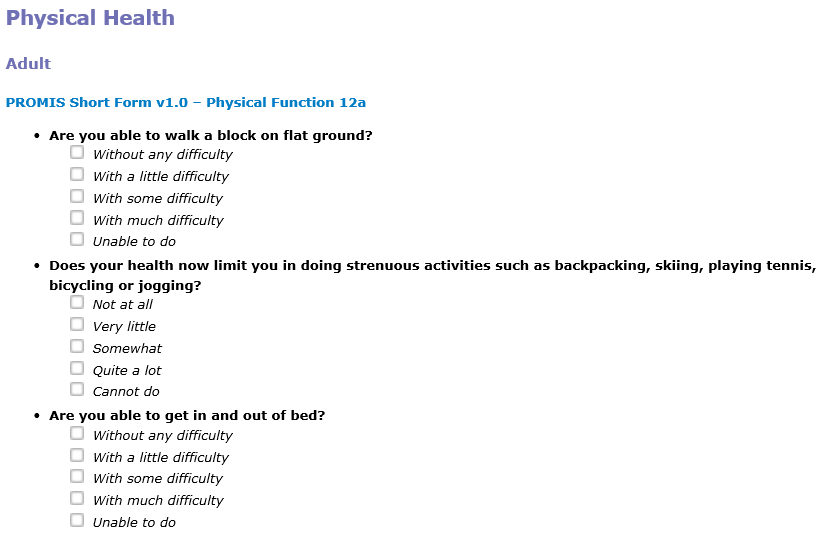Supporting Technologies
Consumer E-Health and Health Metrics -> Health MetricsThree examples of personal health metrics used in a clinical setting include the Health-Related Quality of Life (HRQOL) metric, the Optimal Lifestyle Metric, and the Patient Reported Outcomes Measurement Information System (PROMIS). Each of these are validated measures of personal health based on a patient’s self-report to a clinician.
Health-Related Quality of Life Metrics
Although everyone has their own interpretation of “quality of life,” the challenge for researchers is to define it and figure out a way to measure it. Health is one domain of overall quality of life. Others include jobs, housing, schools, and the neighborhood one lives in. Culture, values, and spirituality also contribute to quality of life. These concepts are explored on a CDC site.
Several measures have been used to assess the HRQOL and functional status. The CDC defines HRQOL as “an individual’s or group’s perceived physical and mental health over time.” For individuals, HRQOL measures try to quantify health risks and conditions, functional status, social support, and socioeconomic status. On the community level, HRQOL includes the resources, conditions and policies that influence a population’s perceived health and functional status. HRQOL questions help clinicians or public health workers understand a person’s or population’s needs. Interestingly, when a person does a self-assessment of their own health status, it can be an even more accurate predictor of mortality and morbidity than many objective measures of health. Several measures have been used to assess HRQOL and functional status, such as:
- Medical Outcomes Study Short Forms (SF-12 and SF-36). These are now being used by the Health Care Financing Administration (HCFA) and the National Committee for Quality Assurance’s Health Plan Employer Data and Information Set (HEDIS 3.0) to help evaluate a patient’s perception of the quality of care they are receiving from managed care plans.
- Sickness Impact Profile. This is a 68-question objective measure designed to assess quality of life and level of dysfunction that results from disability or illness.
- Quality of Well-Being Scale. This scale was developed in the 1970s to measure HRQOL. The widespread use of it has been low because of its length and how difficult it is to administer, as described in this study.
These tools have been extensively validated in clinical settings and special population studies.
Optimal Lifestyle Metric
The Optimal Lifestyle Metric (OLM) reflects adherence to multiple positive health behaviors: not using tobacco, exercising at least 150 minutes per week, consuming at least five fruits and vegetable servings per day, and consuming 2 drinks per day or less for men, and 1 drink per day or less for women. The figure below shows the definition of each criteria as well as the guideline reference.
Source: An Optimal Lifestyle Metric: Four Simple Behaviors that Affect Health, Cost and Productivity
In a worksite health promotion program, employees were asked to complete a baseline health assessment, and a follow-up health assessment two years later (n=6,848). The study found:
- Adherence to any three components of the OLM was associated with 44% less risk of new diabetes and 29% less risk of new back pain.
- Adherence to all four components was associated with 66% less risk of new back pain.
- Adherence to adequate physical activity resulted in less risk of developing chronic conditions within the 2-year timeframe.
Patient Reported Outcomes Measurement Information System (PROMIS)
Patient Reported Outcomes Measurement Information System (PROMIS), funded by the National Institutes of Health (NIH), is a system of highly reliable assessment tools that measure patient–reported health status. The PROMIS® Computer Adaptive Test (CAT) allows computer software to select the most informative follow-up question from validated question banks based on the person’s response to the initial question (see sample physical health questions in figure below).
After finishing the survey, the CAT will show the respondent how their health compares to the general public and people who are similar in age and gender on up to nine different domains of health: physical function, pain intensity, pain interference, fatigue, sleep disturbance, depression, anxiety, social function, and global health (see diagram below).
Examples of Standardized PROMIS Physical Health Questions for Adults
Source: PROMIS website, Measures Tab, Sample Questions
Source: https://www.nihpromis.org/measures/domainframework1



